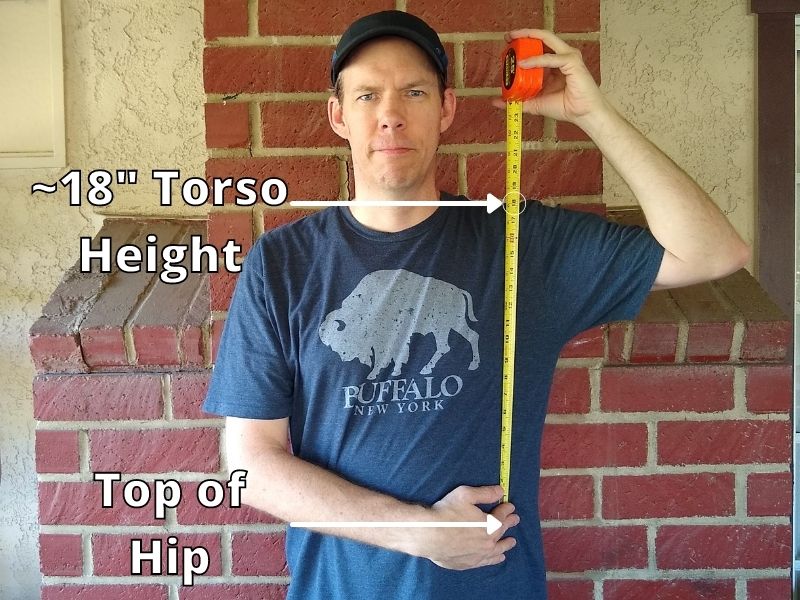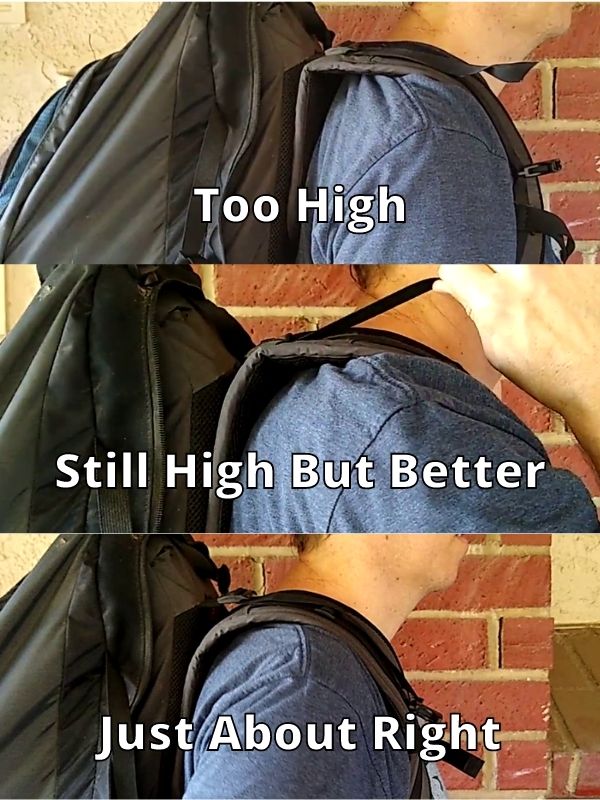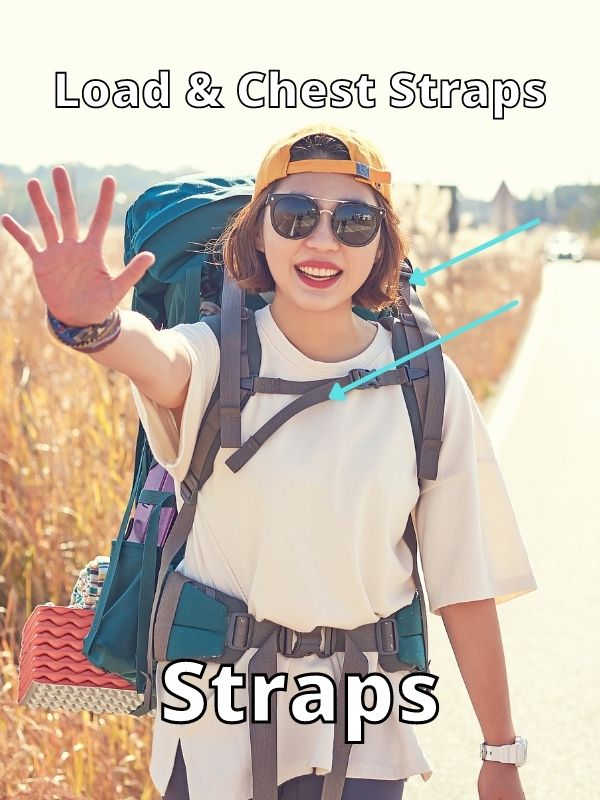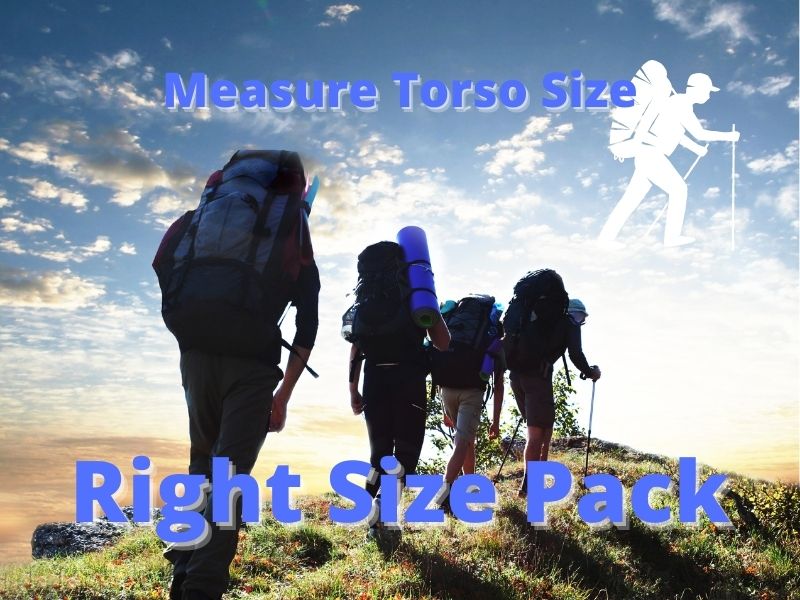Picking the right size of your hiking pack is certainly easier said than done. When I’ve gone hiking for several days in a row, backpack fit made a difference for me.
Your hiking backpack should fit correctly from the top of your hip bones to the top of your shoulder. When adjusted and secured, your backpack hip belt will rest on your hips and the shoulder straps should naturally lye on your shoulders with little to no adjustment needed.
If you have to loosen or tighten the shoulder straps a lot then you likely have the wrong length backpack. Many newer backpacks have adjustable torso lengths. To fit your backpack just right and find the right size for a day or multiday trip we’ll discuss how to get just the right pack for you.
Measuring Hiking Backpacks For Best Fit

Measure Torso Length
Before buying a backpack it’s helpful to measure your torso height. The measurement needed is from the top of your hip bone to the top of your shoulder where the backpack strap will lye.
You can use a tape measure to measure from the top of the hip bone to the shoulder top directly above the hip. This should give you your torso height fairly accurately. It right where the shoulder meets the neck.

At rei.com they say to ” Tilt your head forward and feel for the bony bump” and measure the distance between “the imaginary line between” made by the top of both hip bones and the bony bump.
Buying a Backpack
Now that you have your measurement you can go look for a backpack. It’s always best to try on a backpack in person, so I recommend going to a store to get the best fit.
Although you might be able to get a great fit when buying a backpack online if you buy an adjustable backpack. One that has adjustable shoulder straps so it will fit your torso length no matter how short or tall you are.
Then you can use your measurement to raise or lower the shoulder straps to the correct height. If your backpack is not adjustable then you might see labels for backpack size and use that to guide you.
Non-Adjustable Torso Backpacks

Not all backpacks have adjustable shoulder straps, so the other method you can use is to use your torso measurement and find a backpack that measures close to your torso height.
Various brands are sized differently. A short torso would likely do best with a small backpack but it’s best to measure in person the size of the pack to get the best fit.
Backpacks are available in a range of sizes – both in height and width – meaning that there’s definitely an ideal one out there for everyone. If you order online, make sure you can return it if the pack doesn’t fit correctly.
If you’re particularly tall or large, it might be best for you to buy one in person, so have a chance to avoid the need to return your backpack and wait for a while.
If it doesn’t fit perfectly straight away, double-check that you have adjusted everything correctly. The first thing to fit correctly is the hip belt.
Adjusting Backpack Hip Belt
The second most important measurement is your hips. Most backpacks will fit any hip size, but make the straps too loose or tight can make your backpack positioned incorrectly. If your hip belt doesn’t fit then some backpacks allow you to switch out the hip belt for another one.
Your hip belt may come with a variety of adjustable straps so they can be fit you just right.
The goal is for most of the weight (between 70 and 80 percent) from your backpack to be placed on your hips. So making the hip belt snug yet comfortable is important.
The hip belt should lye on the top of the hips so it can carry a majority of your pack’s weight. Once the hip belt is snug you should feel the weight of the backpack lying on your hips so that if you loosened the shoulder straps the backpack would sit on the hips and not slide down as you walk.
Adjusting Backpack Shoulder Straps
When the hip belt is adjusted correctly the shoulder straps should lye on your shoulders snuggly. Only about 20% of the weight of the pack is placed on the shoulders.
Depending on the strap shape, the shoulder straps will either form a C shape over the shoulder or an arc-like bridge shape. Once the hip belt is snug you should be able to get an idea if the straps are too high or too low.
If the area where the shoulder strap is attached to the backpack is too high you will likely feel little pressure on the top of your shoulders. If the straps are too low it may feel like too much weight is on your shoulders.
According to rei.com the straps should be ” 1 to 2 inches below the top of your shoulders.”
On my backpack I need to adjust the shoulder strap two levels lower to get the optimal fit.

Not all backpacks have adjustable straps, so yours might attach at a different place and be just fine. Just make sure there aren’t any strange angles where the strap attaches too high or too low.
Backpack Load Straps and Chest Strap

When you are hiking for long distances you want to get the best fit for your backpack. Load-lifters and chest straps can help take the load off of your back and place it more squarely on your legs and shoulders.
Load-lifter straps help bring the backpack closer to your back, so it’s not putting pressure on your lower back. They should form a 45-degree angle when tightened if your shoulder straps are at the correct height. (You may have noticed my shoulder straps are at the wrong angle. I am missing the upper strap attachment so I am using the lower ones for support.)
The chest strap can also help prevent the backpack shoulder straps from slipping down the shoulders, which could also impact your lower back. It helps your backpack stay tight against your body and can help prevent backpack shifting.
How Many Liters Should Your Backpack Be

Most backpacks are measured in internal volume rather than external size. This is measured in liters. The total size will usually include the main compartment itself, as well as any other added compartments when zipped up.
The best thing to do is to see the backpack in person, then you’ll know exactly how big it is.
Hiking Backpack Size
The first thing you’ll need in order to determine the ideal hiking bag is the length of your hike. Hiking for a few hours can be fine with just a small day backpack, whilst hiking for days on end will require something larger.
Not only this, but it’s also a good idea to know what type of hiking you’ll be doing, and in what kind of environment. Different terrains, seasons, and even temperatures can decide what you’ll need to bring.
An easy hike in the summer might require only a rain jacket, sunglasses, and some water, whilst a long hike in winter might require various extra layers, food rations, and even ice- or snow-specific gear.
The most important thing to remember is to bring the least amount of things possible, whilst still having everything that’s essential to your trip. Types of Hiking Bags Depending on the Length of Your Trip. The length of your trip is a factor in determining which size of hiking bad is best – we’ll go over this now:
Day Bags (1 Day)
Day backpacks are usually between 20 and 30 liters, with some as small as 10 liters.
An ultra-compact backpack can be great for just a few hours, but anything longer and you’ll want
something that’s suitable for a whole day – so around 10-30 liters.
You’ll want enough room for extra layers, accessories/gear, and of course some food and water.
If you need to bring some bulkier clothing, or other gear, such as cameras or snow gear, stretching to 40-45 liters would be ideal. Although this is quite sizeable, it’s still a great size for a day backpack.
Weekend Bags (1-3 Days)
Staying overnight can make a huge difference to the size of the backpack you’ll need because you’re likely going to need to bring a lot more stuff.
Depending on your sleeping arrangements, you may need to bring a sleeping bag, tent, as well as cooking equipment, and enough food for 2-3 days.
Even if you’re a light packer, you’ll still want something around 30-50 liters to deal with all of the stuff.
Multi-Day Bags (3-5 Days)
If you’re staying for a number of nights, you’ll, of course, need an even bigger backpack. This means you’ll need more clothes, food, and cooking supplies, as well as any gear.
Because of this, you’ll likely be looking in the region of 50-75 liters, but this can vary greatly from person to person, as well as depending on where you’re staying, and what climate you’re in.
Expedition Bags (5+ Days)
Expedition backpacks are in a league of their own. They usually range from 75 to 100 liters, with some going up to 120 liters, and even more!
They’re designed so you can fit absolutely everything you’ll need inside them. Not only this, but some top-end models have expanding parts, so they can range in size depending on the trip you’re taking.
For example, unzipping a pocket can add an extra 10 liters, making it an 80 to 90-liter backpack.
Although these aren’t always the easiest to carry, they’re the best choice in guaranteeing you’ll be able to bring absolutely everything you need for the trip.
Bear in mind though that, because of their size, they don’t come cheap.
Specific Types of Backpacks
Women Backpacks
Some retailers have women-specific backpacks. They tend to be a bit shorter and with shorter straps, to fit slightly smaller and slimmer frames. Some also have contouring that’s better suited for women.
Youth Backpacks
Similar to women-specific backpacks, youth or ‘junior’ backpacks are slimmer and shorter making them more suitable for children or smaller people in general.
Most also accommodate some growing room, as their adjustable straps mean they can still fit you for years to come.
Final Thoughts
There are various sizes, volumes, and shapes of backpacks to choose from, but by considering the type of activities you’re planning to do, as well as your own shape and size, you’re guaranteed to find one that’s ideal for you, both in budget and usability.
Hopefully, now you know how to choose the right size of hiking bags
Thanks for visiting Helpshoe.com
References
https://www.rei.com/learn/expert-advice/backpack.html
https://www.hyperlitemountaingear.com/pages/hiking-backpack-size-chart

